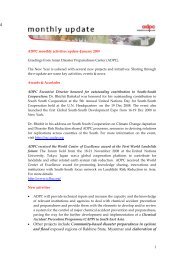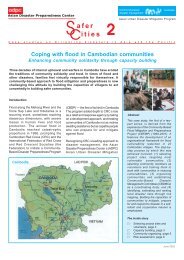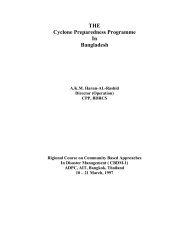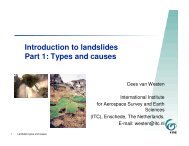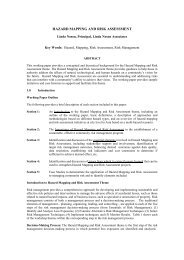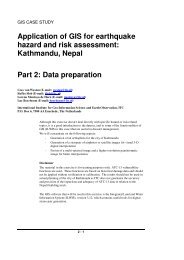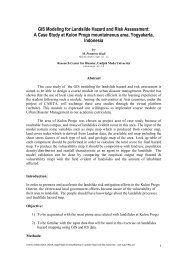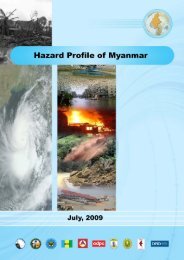community-based disaster risk management and the media media kit
community-based disaster risk management and the media media kit
community-based disaster risk management and the media media kit
Create successful ePaper yourself
Turn your PDF publications into a flip-book with our unique Google optimized e-Paper software.
chapter 1. introduction to <strong>disaster</strong> <strong>risk</strong> <strong>management</strong><br />
ability of <strong>the</strong> affected communities to cope using <strong>the</strong>ir own resources.<br />
Disasters occur when <strong>the</strong> negative effects of <strong>the</strong> hazards are not well<br />
managed.<br />
Disaster Risk Management. A systematic application of <strong>management</strong><br />
policies, procedures <strong>and</strong> practices to identify, analyze, assess, treat,<br />
monitor <strong>and</strong> evaluate <strong>risk</strong>s. This involves decision-making <strong>based</strong> on <strong>the</strong><br />
examination of those <strong>risk</strong>s, which includes hazard, vulnerability, <strong>and</strong><br />
capacity of people <strong>and</strong> institutions.<br />
Early warning. The provision of timely <strong>and</strong> effective information,<br />
through identifi ed institutions, that allows those exposed to a hazard<br />
to act to avoid or reduce <strong>the</strong>ir <strong>risk</strong> <strong>and</strong> prepare for effective response.<br />
Early warning systems include: underst<strong>and</strong>ing <strong>and</strong> mapping <strong>the</strong><br />
hazard; monitoring <strong>and</strong> forecasting impending events; processing <strong>and</strong><br />
disseminating underst<strong>and</strong>able warnings to political authorities <strong>and</strong> <strong>the</strong><br />
population; <strong>and</strong> undertaking appropriate <strong>and</strong> timely actions in response<br />
to <strong>the</strong> warnings.<br />
Emergency <strong>management</strong>. The organization <strong>and</strong> <strong>management</strong> of<br />
resources <strong>and</strong> responsibilities for dealing with all aspects of emergencies,<br />
particularly in preparedness, response <strong>and</strong> rehabilitation. Emergency<br />
<strong>management</strong> involves plans, structures <strong>and</strong> arrangements established<br />
to engage <strong>the</strong> normal endeavors of government, voluntary <strong>and</strong> private<br />
agencies in a comprehensive <strong>and</strong> coordinated way to respond to <strong>the</strong><br />
whole spectrum of emergency needs.<br />
Hazard. Any phenomenon, substance or situation, which has <strong>the</strong><br />
potential to cause disruption or damage to infrastructure <strong>and</strong> services,<br />
people, <strong>the</strong>ir property <strong>and</strong> <strong>the</strong>ir environment. There are many kinds of<br />
hazards. Some are mentioned below:<br />
Biological hazard. Processes of organic origin or those conveyed<br />
by biological vectors, including exposure to micro-organisms, toxins<br />
<strong>and</strong> bioactive substances.<br />
Geological hazard. Natural earth processes or phenomena caused<br />
by earth movements. Geological hazards include earthquakes,<br />
tsunami, l<strong>and</strong>slides, <strong>and</strong> volcanic erosion.<br />
19



